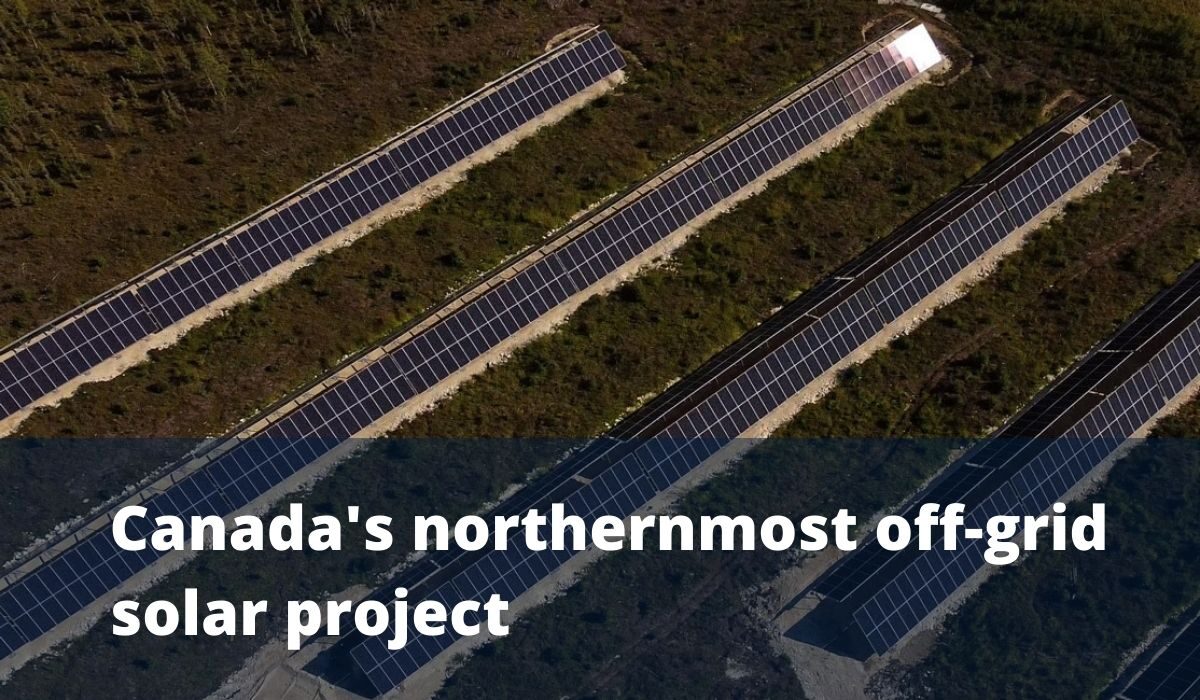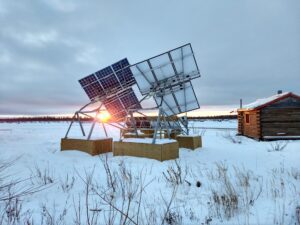A small, isolated village in Arctic Canada becomes a green energy producer

Old Crow is a small village in Yukon Territory, with a population of only 250 people. With no road connection and being off the electricity grid, it is a truly isolated place in Arctic Canada. In 2021 Old Crow has launched the solar farm, and now 25 per cent of the community electrical demands are covered by green energy.
AEC Advisor Irina Zhilina talked with Jay Massie, Vice President, Northern Development & Indigenous Relations at ATCO Electric, about the company’s role in the project, green transition, capacity building, and economic development in the Arctic.
What was the background for ATCO to be involved?
ATCO Electric Yukon (ATCO) has a long-standing relationship with the Vuntut Gwitchin Government (VGG). We have worked closely with the VGG over the past 50-60 years as the existing Utility provider operating in the community of Old Crow. When the community began exploring renewable options, we worked with them to ensure that the project, once built, would operate seamlessly with the existing power system.
This was a community-led project from the beginning. Old Crow had a community champion who was interested in exploring renewable energy options, and they were the driving force behind this project. The community was ahead of the curve and envisioned the project before there was an Independent Power Producer (IPP) policy in place. This made the project challenging in terms of regulated electrical policy and how this hybrid model would work with our regulator in terms of rates.
Throughout this process, relationships were key. While we had a long-standing relationship with the VGG, continued trust was critical as we entered into this new partnership.
How did the indigenous community in Old Crow become an independent power producer and an owner of the solar farm?
The project in Old Crow began to take shape before a formal IPP policy was established in the Yukon. Based on our experiences working in communities across the Yukon, ATCO was provided an opportunity to lend our voice and expertise as that policy was being developed.
As Independent Power Producers, the community is an owner of the solar-generated power. The community designed, built and funded the renewable generation field, and ATCO acted as the technical lead to confirm that the community’s renewable generation worked with the existing power system. This structure ensured that residents in the community did not notice a difference in the reliability of their power, and there was no effect on rates.

What economic impact do you anticipate the project will bring into the community?
With the VGG serving as an IPP, and owner-operator of the solar facility, they have created a reliable revenue stream for their community. For the next 25 years, ATCO will purchase the solar electricity generated from this project and feed it back into the grid to redistribute to the community.
Since the community is an IPP, their economic structure and financing are rightfully managed by the VGG, so the community would determine any direct financial impacts. We can share that through this project, the community has reduced their reliance on diesel use by 190,000 litres annually. By adopting this IPP model, the community is paid the same amount it would cost AEY to produce electricity through diesel generation.
How can other small and remote Arctic communities benefit from this example of green transitioning?
There are many benefits for small and remote Arctic communities interested in exploring this example of green transitioning.
From an environmental standpoint, not only does this model remove 190,000 litres of diesel from being burned in Old Crow, it also eliminates the emissions produced throughout the entire life cycle of the product. When you consider the supply chain and logistics of transporting that much diesel to a remote, fly-in community in the Arctic, we also remove the risks associated with potential fuel spills.
I think there are a lot of communities that could benefit from this unique commercial model. While the solar technology that was implemented is not necessarily new or innovative, you need a solid technical team to ensure that everything works with the existing infrastructure. The commercial model itself is where the innovation comes in. This hybrid model created a blueprint for how an IPP can work together with a Utility provider to ensure they are making a healthy return on their renewable investment without impacting rates on the consumer side.

How does the project address the challenge of competence-building?
While the community had a champion behind this project, typically most remote, isolated communities are not involved in the utility power systems. This project has sparked a lot of interest and discussion about renewable energy within the community. It has increased energy literacy amongst residents, who are now engaged in exploring future possibilities to reduce their reliance on diesel consumption further.
How efficient is the use of solar energy in the Arctic?
The use of solar energy in the Arctic is quite efficient. The system may not generate an abundance of energy in the dark winter months, but it is pretty impressive how much solar generation takes place in March and April, despite the temperatures still hovering around -20 degrees. The sun refracts off the snow and contributes more to the generation of energy, so it is still bright enough to produce energy while it is cold. This project has offset 25% of the community’s annual electricity needs, which are now covered by the sun.
Will ATCO expand this project to other places?
Absolutely. We are actively seeking communities that are interested in exploring renewable energy options. As we look at the 200+ isolated communities across Canada, we recognize a tremendous opportunity to implement a similar hybrid model and establish mutually beneficial partnerships.
We have developed a unique template that is proven to work in the North. Our engineering design teams have the technical expertise to tailor unique solutions for each community.
If a community is interested in participating or learning more about this process, I encourage them to reach out to me directly.
Photo credit: ATCO Group
Facts:
- Jay Massie is Vice President, Northern Development & Indigenous Relations at ATCO. If you would like to get in contact with Mr. Massie, you can write to in**@ar*******************.com
- ATCO is an engineering, logistics and energy holding company based in Calgary, Alberta. ATCO has been a member of the Arctic Economic Council since its establishment in 2014.
If you are interested more in the Old Crow Solar Project you can read an article by the Arctic Council Powered by Nature: The Old Crow Solar Project, that provides insights from the Arctic community
This article was originally posted on the AEC website.